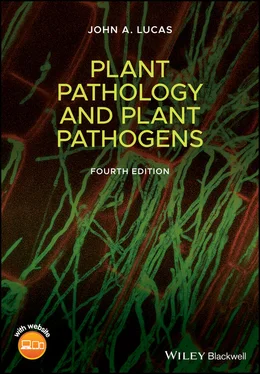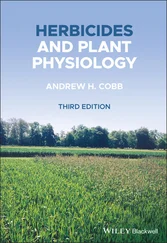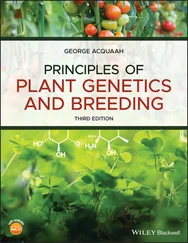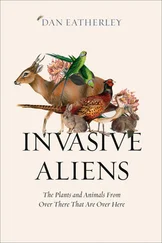
Figure 2.5 Use of Koch’s postulates to establish the etiology of a new disease of citrus caused by the bacterium Xylella fastidiosa .
Source: Based on Hartung et al. (1994).
The application of Koch's rules to nonculturable fungal pathogens presents fewer problems because these agents produce spores. Such propagules can be removed from the host and then used in reinoculation experiments. In many instances, spore morphology is also a valuable aid to identification of the inoculated and reisolated pathogens.
Further difficulties in satisfying these postulates may be experienced in cases where symptoms result from mixed infections or when dealing with previously undescribed disease agents. For instance, few pathologists would have predicted the existence of the viroids, which scarcely conform to our preconceptions of a successful parasite (see Chapter 3).
Host Resistance and Pathogen Virulence
All crops are exposed to a wide variety of potentially pathogenic microorganisms present in soil, water, and the surrounding atmosphere. Yet most plants remain healthy most of the time. Consequently, the majority of pathogens are unable to infect the plants with which they come into contact. Even where a specific pathogen can attack a particular host species, there are marked variations in the extent to which individual plants succumb to disease. These differences are paralleled by variation in the pathogen population, reflecting differences in the genetic constitution of both the host and the pathogen. The ability of the pathogen to cause disease, and the host to respond to invasion, has been shown to be determined by specific genes. This discovery has important implications both in the analysis of disease and in its control.
Resistance and Susceptibility
When a microorganism makes contact with a plant, it may be able to penetrate the potential host or it may be completely excluded. Following penetration, development of the pathogen may be halted by a host response or, alternatively, growth continues within the host tissues.
Describing the interaction between a microbial pathogen and its host presents problems as the outcome needs to be defined in terms of both partners ( Figure 2.6). At one extreme is the situation where a microorganism is incapable of causing disease in the host under any conditions, and so is described as a nonpathogen of that host. Likewise, plants able to completely prevent penetration by a microbial agent are nonhosts, and are considered to be immune to that organism. The majority of interactions between microbes and green plants are likely to be of this type. It may, however, be difficult to establish whether a plant is immune to a particular pathogen, as the absence of visible symptoms does not automatically imply a failure to penetrate. Nowadays, the term immunityis mainly used in the context of innate plant defense, or should only be applied in cases where precise descriptions of the microbe–plant interactions are available.

Figure 2.6 Relationships between host, pathogen, and disease reaction.
In some instances, (see Chapter 9), pathogens penetrate their host only to be immediately prevented from further colonization by the death of the first living cells they enter. Such restricted development indicates that the host is resistantto the pathogen. Resistance, unlike immunity, is not an all‐or‐nothing property of the host. In practice, there may be a whole range of responses, varying from high resistance, where no visible symptoms are manifest, to low resistance, where the host succumbs completely to disease. Between these two extremes, resistance is described by a number of adjectives which, though imprecise, are of practical use in distinguishing between host reaction types.
Alternatively, differing degrees of pathogen development may be described in terms of host susceptibility( Figure 2.6). For each degree of resistance, there is a corresponding level of susceptibility. For instance, high resistance is equivalent to low susceptibility. Complete susceptibility is of considerable biological interest, as it appears to constitute the exception to the general rule that plants exhibit a degree of resistance. However, in this book these complementary descriptions of host responses are mainly considered in terms of resistance. This approach has significant practical advantages in that it emphasizes the character which is selected for by plant breeders (see Chapter 12).
The terms resistance and susceptibility describe conditions of the host. However, just as the host may vary in its ability to resist infection, so pathogens differ in their ability to invade and cause disease. Those microorganisms which cannot under normal circumstances induce disease in a host are regarded as nonpathogenic with respect to that host. Others which are able to penetrate but which have insignificant effects on the host may be termed avirulent; where the effects are more drastic, they are described as possessing some degree of virulence.
It should be noted that there are still some problems with this terminology. In clinical microbiology, a distinction was originally drawn between nonpathogenic and pathogenic microorganisms. Pathogenicity was considered to be an absolute property. Virulence was used to describe differences in the extent to which different strains of a pathogen caused disease. These clear‐cut distinctions are valid for some pathogenic species, but it is now appreciated that the situation is more complex. Many microorganisms have the ability to acquire or lose traits which have a major effect on disease reaction type.
Ultimately, the phenomenon of pathogenicity needs to be analyzed in genetic terms, and the differences between species, strains, and pathotypes described in terms of the molecular interactions determining the disease phenotype. Avirulence, for instance, has a more precise meaning associated with the presence in the pathogen of a specific gene encoding a product which can be recognized by the plant, hence triggering resistance (see later in this chapter and Chapter 9). Hence some authors prefer to use the term aggressivenessto describe differences between pathogen strains in the amount of disease they cause in the host. Aggressiveness can only be measured under carefully controlled conditions where each pathogen strain is inoculated onto a defined host genotype in the same environment, allowing quantification of a range of different parameters ( Table 2.2). Change in the aggressiveness of a pathogen is sometimes an important factor in the emergence of new invasive strains or increases in the severity of disease epidemics. For instance, the recent spread of yellow rust ( Puccinia striiformis ) to new regions has been linked to the appearance of strains with a more rapid disease cycle, greater production of spores, and the ability to cause epidemics under warmer conditions than those favored by previous strains.
Table 2.2 Some parameters used to measure aggressiveness
| Length of latent period (time from inoculation to production of new inoculum) |
| Rate of multiplication of the pathogen in host tissues (used for bacteria and viruses) |
| Rate of lesion expansion |
| Number of lesions produced per amount of initial inoculum |
| Eventual lesion size or extent of host tissue infected |
| Number of spores or cells produced per unit area of host tissue |
Genetic Control of Resistance and Virulence
Читать дальше













